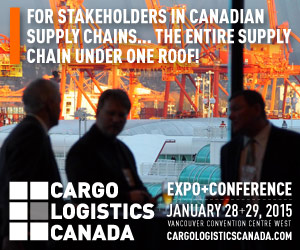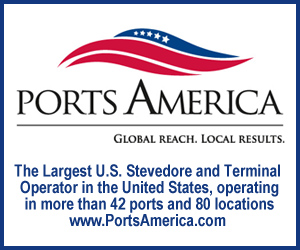
Monday, September 22, 2014
Top Story
West Coast port labor negotiations tackle automation
 As they negotiate a new contract for up to 20,000 West Coast dockworkers, the International Longshore and Warehouse Union and the Pacific Maritime Association must address the thorny issue of increasing automation, as terminal operators replace as many as half the laborers at some ports with robots in the biggest technological change in 50 years.
As they negotiate a new contract for up to 20,000 West Coast dockworkers, the International Longshore and Warehouse Union and the Pacific Maritime Association must address the thorny issue of increasing automation, as terminal operators replace as many as half the laborers at some ports with robots in the biggest technological change in 50 years.
The two parties are discussing how to retrain and preserve jobs for longshore workers, since automation will decrease the number of jobs at one Los Angeles terminal by 40 to 50 percent once changes are completed in 2016, according to a Harbor Department report released in April.
"In the U.S., the extent to which automation of container terminals affects the number of longshoremen’s jobs depends on negotiations between the employers and unions," said Neil Davidson, a senior analyst at Drewry Maritime Research via e-mail. "Employers aren’t simply free to decide to reduce jobs. In addition, it depends on the nature of the automation."
More than two months after a six-year agreement expired, the ILWU and the PMA are trying to strike a new contract for West Coast dockworkers. A strike or lockout could cost the U.S. economy up to $2 billion a day, according to the National Retail Federation and National Association of Manufacturers.
Los Angeles and Long Beach port terminal operators are installing equipment that moves containers from ships to shore cranes and trucks with minimal human labor. The first large-scale automation project will involve a TraPac Inc. terminal at the Port of Los Angeles in 2016. Orient Overseas Container Line at Long Beach will add robots as part of a $1.3 billion project to upgrade two container terminals by 2019.
"New technology is a fact of life," said Craig Merrilees, a spokesman for the union. "The best approach is for workers and management to agree on terms that are fair and beneficial for all involved. That approach was successful when containers were introduced on the waterfront over 50 years ago, and it remains the best approach today."
PMA spokesman Wade Gates declined to comment on the talks or the role of automation.
According to the Los Angeles Harbor Department report, technology at L.A.’s TraPac terminal will probably reduce the number of workers needed per crane by about 53 percent, and by 85 percent at transtainers, which are hoisting devices for loading and unloading cargo from rail cars or trucks.
The 27 West Coast ports are worried about competition from rivals on the East Coast and Texas once the Panama Canal opens in 2016.
The port labor talks are continuing as West Coast dockworkers stay on the job.
For more of the Bloomberg story: www.bloomberg.com
More Newswire stories
Maersk talks 2M with Chinese regulators
S.C. port volume up 13 percent, port CEO gets raise and bonus
Oil-by-rail continues to stall shipment of U.S. grain bumper crop
Crane collapses at Lyttelton Port


Home | The Magazine | Conferences | Port Handbooks | Newswire | Advertise | Ocean Schedules | Contact
CBN Archives | About CBN | Subscribe to CBN | Marine Fuels Conference | Southeast Freight Conference | Heartland Shippers’ Conference | Port Productivity Conference | Pacific Northwest Ports Handbook
Golden Gates Ports Handbook | Southern California Ports Handbook | Buy Handbooks | Subscirbe to Newswire | Newswire Archives | Upload Files






